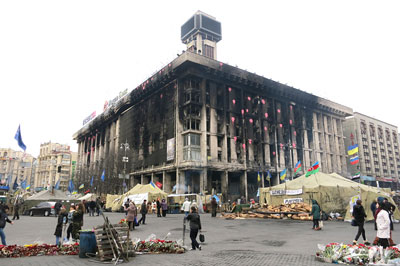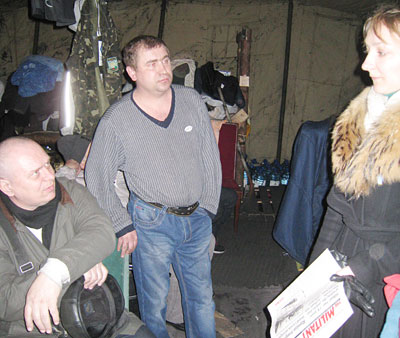(lead article)
Working people at center of
fight for Ukraine sovereignty
Militant’s on-the-scene report from Kiev


| Militant photos: Above, John Studer; Inset, Dag Tirsén |
|
Above, Trade union headquarters at Maidan burned out by police during February actions. Unions opened it for organization of self-defense forces, hospital services and food distribution. Circles of red paint on building each symbolize someone killed in fight to oust government of President Viktor Yanukovych. At right is tent for protesters from Donetsk region. Inset, Inside Donetsk tent. From left, Demitri Antoliavych, miner Sasha Antoliavych and Oksana Demynovych, part of Militant reporting team.
|
BY JOHN STUDER
KIEV, Ukraine — “We are among the workers who have come to Maidan recently,” said Sasha Antoliavych, a former miner from the Donetsk region bordering Russia in eastern Ukraine March 17, the day after Moscow stepped up its moves to annex the Crimea following a sham referendum. “We plan to stay here to help organize to defend our country from Russia.”
Antoliavych is one of thousands from across Ukraine who remain encamped in the Maidan — Independence Square — after overthrowing the pro-Moscow government of President Victor Yanukovych.
“While we watch Russia,” Antoliavych said, “we also watch the politicians of the new government. Most of them are not much different from those who fled.”
A team of Militant correspondents talked with dozens of workers and others at various tents set up in the Maidan, many of which are organized by region.
Alexei, who is staying in the tent of protesters from Sevastopol, Crimea, said that some opponents of the Russian occupation there have fled the region.
Alexei, who didn’t give his last name for fear of reprisals against others in Crimea, showed a copy of an affidavit from a Crimean resident named Igor who said he was interrogated, threatened and forced to leave his home by self-described members of the “Russian Bloc” because of his support for the Maidan protests.
“The fight against Yanukovych united people from different regions — it was a real national battle for our country,” said Mykola Bondar, who has been at the Maidan since November, when they began organizing self-defense units to protect the few hundred mostly students who were protesting moves by the Yanukovych government to keep Ukraine under Russian domination.
Over the next three months demonstrations grew and spread as more than 1 million workers, farmers and others joined mobilizations in Kiev and across the country.
The protests reached a climax Feb. 18-20, when Yanukovych ordered the Berkut riot police to drive protesters out of the Madian, killing more than 100. The attack failed, the riot police melted away and Yanukovych fled to Russia Feb. 22. A veteran of the Soviet military campaign during the 1979-89 war in Afghanistan, Bondar helped train the self-defense units. “We had problems with provocations from some groups,” said Bondar. “Svoboda, for example, tore down the Lenin statue in the square to get publicity for their party.”
Svoboda, a rightist party with a military wing and a reputation for strong-arm tactics, attempted other provocations, Bondar said, including driving cars at police lines. Smashing statues of Lenin has given a handle to Moscow’s media campaign to smear demonstrators as “fascists” and created obstacles to uniting workers from west to east against Russian domination.
“The Trade Unions House was the military headquarters, the location of our food stocks and the hospital on the square,” Bondar said. “We would put the word out about what supplies we needed and people from everywhere brought them.” The Berkut set fire to the building in the midst of the February battles.
Union members join Maidan protests
Vasyl Andreyev, chair of the Ukraine Building Workers’ Union, said in a Feb. 25 interview published on the Building and Wood Worker’s International website that although his union did not officially back the movement to oust Yanukovych, “many members decided to go to the barricades.”
“The new politicians keep trying to get us to shut down the Maidan,” Bondar said.
“We have to keep this going,” added Konstantyn Samoylenko. “There are very few politicians who are not touched by the oligarchs, the millionaires. Those who own the banks think the economic crisis in Ukraine has to be covered by the workers and the poor people.”
Ukraine has been hard hit by the worldwide capitalist economic crisis. Acting President Oleksandr Tyrchynov says that the country is “heading into the abyss,” with more than $13 billion in loan payments, mostly to European banks, due this year.
Antoliavych said Black Lung disease is prevalent among miners in the Donetz region, whose working and living conditions have gotten worse in recent decades. While the independent miners’ union was part of the fight for Ukrainian independence in the 1980s and ’90s, before the fall of the Soviet Union, he said, union officials today do little to protect miners.
The only source of news in the eastern mining areas is Russian television, which is full of lies about Maidan, Antoliavych said. Coal bosses tried to prevent miners from joining the Kiev protests by offering overtime bonuses to stay and work.
“I hope that these events and the Maidan will help change the consciousness of the workers, get them more involved,” said Anya Tchaikovska, who used to work in a bus and construction equipment depot and has been volunteering for the last four months to help coordinate food supplies. “If workers’ demands are not met, there will have to be another Maidan,” she said.
Related articles:
Protesters in London demand Russian troops out of Crimea
March in Toronto backs Ukrainian sovereignty
Moscow moves to seize Ukraine after sham vote
Moscow rally protests Russian occupation of Crimea
|



